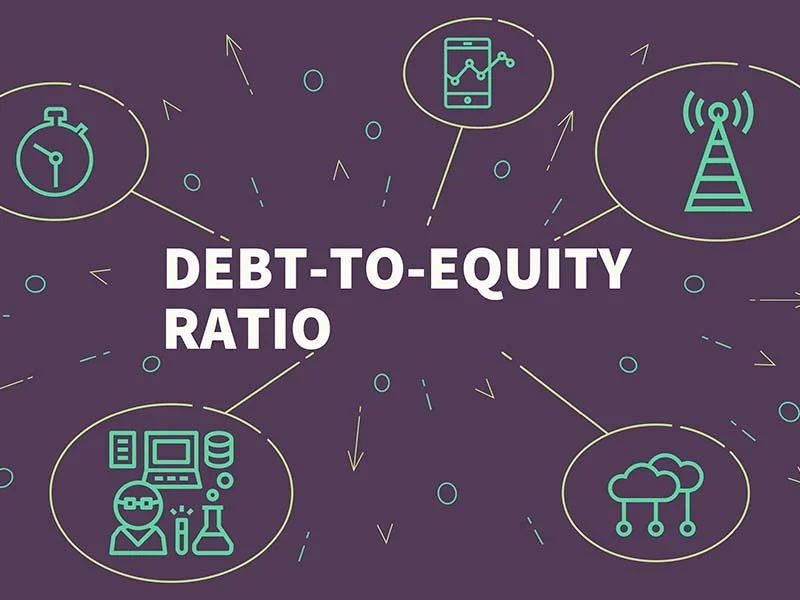Deciphering the Financial Landscape: Unveiling the Debt-to-Equity (D/E) Ratio
In the intricate world of corporate finance, the Debt-to-Equity (D/E) ratio emerges as a crucial metric, a compass guiding investors through the labyrinth of financial leverage. This ratio, a subset of gearing ratios, offers insights into how a company finances its operations—whether through debt or internal resources. Join us as we delve into the fundamentals of the D/E ratio, its calculation, significance, applications, and even explore its relevance in personal finance.

The D/E Ratio Formula: Unraveling the Equation
At its core, the D/E ratio measures a company’s financial leverage, calculated by dividing total liabilities by shareholder equity. The formula stands as follows:
Debt/Equity=Total LiabilitiesTotal Shareholders’ Equity
This fundamental equation draws information directly from a company’s balance sheet. By subtracting total liabilities from total assets, the resulting figure represents shareholder equity. However, caution is warranted, as certain balance sheet categories may distort the ratio due to retained earnings, intangible assets, or pension plan adjustments.
Modifying the D/E Ratio: Navigating Distortions
To enhance clarity and facilitate meaningful comparisons, analysts often modify the D/E ratio. This adjustment involves considering short-term leverage ratios, profitability, and growth expectations. These refinements provide a more nuanced perspective on a company’s financial structure.
Calculating D/E Ratio in Excel: A Practical Approach
Practicality meets precision when it comes to calculating the D/E ratio in Excel. Business owners and analysts can utilize Microsoft Excel’s balance sheet template, automating the computation of financial ratios, including the D/E ratio. Alternatively, manual entry of total liabilities and shareholders’ equity into adjacent spreadsheet cells, followed by a simple formula, offers a hands-on approach.
Deciphering the D/E Ratio: What Does It Reveal?
The D/E ratio unfurls a critical narrative about a company’s financial health. It gauges the extent to which a company relies on debt relative to its asset value net of liabilities. A high D/E ratio signals a higher investment risk, indicating predominant reliance on debt financing. While debt-fueled growth can amplify earnings, it introduces interest expenses and potential equity devaluation in the face of default.
The balance between incremental profit from debt-fueled growth and the associated rise in debt service costs shapes the impact of the D/E ratio on shareholder value. Market conditions and the cost of debt influence the profitability of debt-financed endeavors. What initially seems a prudent financial strategy may unravel in unforeseen circumstances.
D/E Ratio in Action: An Apple Inc. Example
Let’s traverse historical terrain with Apple Inc. (AAPL) as an illustrative example. For the fiscal year ending 2017, Apple reported total liabilities of $241 billion and total shareholders’ equity of $134 billion. The D/E ratio calculation unfolds as follows:
Debt-to-equity=$134,000,000,000$241,000,000,000=1.80
This result signifies that Apple had $1.80 of debt for every dollar of equity. However, to gain a comprehensive understanding, investors must compare this ratio with industry peers.
Refining the D/E Ratio: Differentiating Debt Types
Not all debt carries equal risk. The long-term D/E ratio focuses on riskier long-term debt, using its value instead of total liabilities in the numerator. Short-term debt, while contributing to leverage, is considered less risky due to its imminent payment horizon.
Short-term debt tends to be cheaper and less sensitive to interest rate fluctuations. This distinction is crucial in evaluating a company’s risk profile, considering that the ability to service long-term debt hinges on long-term business prospects.
D/E Ratio in Personal Finance: A Personal Touch
The versatility of the D/E ratio extends beyond corporate realms, finding application in personal finance. Termed the personal D/E ratio, it assesses an individual’s financial standing. Equity, in this context, represents the difference between personal assets and liabilities. Lenders employ the personal D/E ratio to gauge an applicant’s ability to meet loan obligations during income disruptions.
Limitations and Considerations: Industry Dynamics Matter
The application of the D/E ratio demands careful consideration of industry dynamics. Industries with varying capital needs and growth rates may exhibit different D/E ratio norms. For instance, utility stocks, with their steady income stream and regulated environment, often carry high D/E ratios, which, in their context, signify efficient capital use.
Analysts must navigate the complexities arising from the inclusion of preferred stock in the D/E ratio. The classification of preferred stock as equity or debt introduces nuances, impacting the perceived riskiness of a company.
Assessing Risk: Rising D/E Ratios and Industry Benchmarking
A steadily increasing D/E ratio poses challenges in obtaining future financing and servicing current loan obligations. Very high D/E ratios may elevate the risk of default or bankruptcy. It’s crucial for investors to benchmark a company’s D/E ratio against industry averages and competitors to ascertain its risk profile accurately.
The Dynamic Nature of a “Good” D/E Ratio: Industry Context Matters
Defining a “good” D/E ratio is contingent upon the nature of the business and its industry. Generally, a D/E ratio below 1 is considered safe, while values of 2 or higher may signal risk. Industry-specific norms play a pivotal role, with sectors like utilities, consumer staples, and banking often exhibiting higher D/E ratios.
Looking Ahead: The Ever-Evolving Financial Landscape
As we navigate the intricate waters of corporate finance, the Debt-to-Equity (D/E) ratio stands as a compass, guiding investors through the nuances of financial leverage. Industry dynamics, risk assessments, and the evolving nature of debt financing shape the narrative of a company’s financial health. In an era of dynamic market conditions, understanding and leveraging the insights offered by the D/E ratio remain paramount for investors, analysts, and businesses alike.






